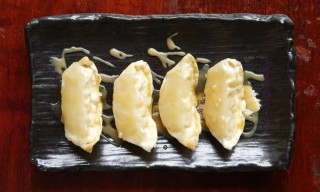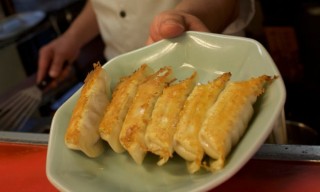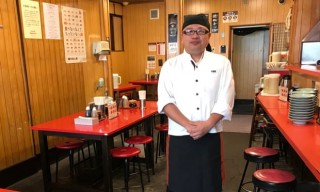Loading
Search
▼ Fight To Become Japan's Gyoza Capital Gently Simmers
- Category:Gourmet
Utsunomiya’s culinary obsession with dumplings dates back to the end of the war, but the city has a new rival
Gyoza are venerated in Japan, where two cities are vying to become the dumpling capital Photograph: Murdo MacLeod/The Guardian
Pan-fried, deep-fried or simmered in boiling water, the humble gyoza is venerated in Japan, but nowhere more so than in Utsunomiya, whose residents have the tiny parcels of pork and cabbage to thank for rescuing their city from obscurity.
The city of just over half a million, 60 miles (100km) north of Tokyo, has built an entire tourist industry around its association with the dumplings, drawing 9 million visitors a year with the sole purpose of eating Utsunomiya’s contribution to Japanese cuisine.
Local experts trace Utsunomiya’s culinary obsession to the end of the war, when soldiers returned with recipes for gyoza they had eaten in Japanese-occupied China, where jiaozi dumplings were first eaten during the Tang dynasty (618-907).
“They were easy to make, nutritious, and none of the ingredients were particularly hard to get hold of,” says Akihiro Suzuki, secretary general of the Utsunomiya Gyoza Association, which represents 96 of the city’s estimated 200 gyoza restaurants.
The region around Utsunomiya produces large quantities of flour and nira garlic chives – two essential ingredients – while green and Chinese cabbages, pork and other ingredients are shipped in from other parts of the country depending on the season.
But the city has a rival for the title of Japan’s gyoza capital. Last year, the residents of Hamamatsu in central Japan spent marginally more on gyoza per household than their counterparts here, sparking a fierce campaign to regain the title when the ministry of internal affairs and communications releases its annual survey of consumer habits early next year.
In last year’s survey, Hamamatsu came out on top, spending an average of ¥3,501 (£23.80) per household on ready-made gyoza from supermarkets, compared with ¥3,241 in Utsunomiya. The latter had finished top for 15 years in a row from 1996, but the title has rotated between the two for most of the past decade.
The first gyoza restaurant opened in Utsunomiya in the early 1950s, with Minmin, now one of the best known producers, launching its flagship restaurant towards the end of the decade. That sparked a surge in consumption and a slew of new restaurants keen to grab their share of the exploding market in dumplings.
‘Everyone likes them’
Utsunomiya’s dumpling binge went largely unnoticed in the rest of Japan until the city featured in a TV programme in 1993. Before long, people were travelling from Tokyo and even farther afield to find out what all the fuss was about. The city’s government, along with local businesses and the media, seized the opportunity to revive tourism, which had slumped after its most popular attraction, the Oya stone mine, collapsed in 1989.
A statue – the Gyoza Venus – was unveiled outside the railway station in 1994, and the city held its first gyoza festival, which last year drew 170,000 people over two days.
“The best thing about gyoza is that everyone likes them, from children to older people. And they’re so versatile,” says Suzuki, who used to eat them every other day but has cut his consumption to about once a week. “They can be part of a complete meal or a snack with beer.”
The gyoza selection has expanded to include versions filled with cheese, fruit and sweet beans. Demand for vegetarian gyoza – made with tofu and soy beans instead of pork – is growing among foreign backpackers who stop in the city on their way to the nearby Nikko national park, according to Suzuki.
But the menu at Minmin’s flagship restaurant, which opened in 1958, is decidedly old school, featuring just three types of gyoza: pan-fried, deep-fried and boiled, dipped in a mixture of soy sauce, rice vinegar and rayu, a chilli-infused oil. They are light on garlic but heavy on cabbage, with minced pork making up only a quarter of each crescent-shaped morsel. The mixture is combined with a tare sauce of soy, mirin, nira, sesame oil, garlic and “secret” ingredients known only to the company’s president and one other member of staff. When demand peaks, the firm’s factory knocks out as many as 130,000 perfectly formed gyoza a day.
Hiroki Nakatsuhara, the manager of Minmin’s oldest restaurant, recommends trying unembellished gyoza first, and then with a smidgeon of dipping sauce – a combination of soy, rice vinegar and rayu chili oil – so as not to overwhelm the flavour of the filling.
“I eat gyoza every day, even if it’s just a few to go with whatever else I’m eating,” says Nakatsuhara. “We don’t overdo the garlic. It’s there to create umami, not to overpower all the other ingredients. They’re really kind on the palate and the texture is wonderful.”
With only weeks to go until Utsunomiya finds out if it has wrested its title from Hamamatsu, Suzuki raises the stakes in the gyoza wars.
“The problem is that the survey only covers gyoza bought from supermarkets,” he says. “If it included those eaten at restaurants I’m sure Utsunomiya would finish top every year.”
- December 24, 2019
- Comment (0)
- Trackback(0)




